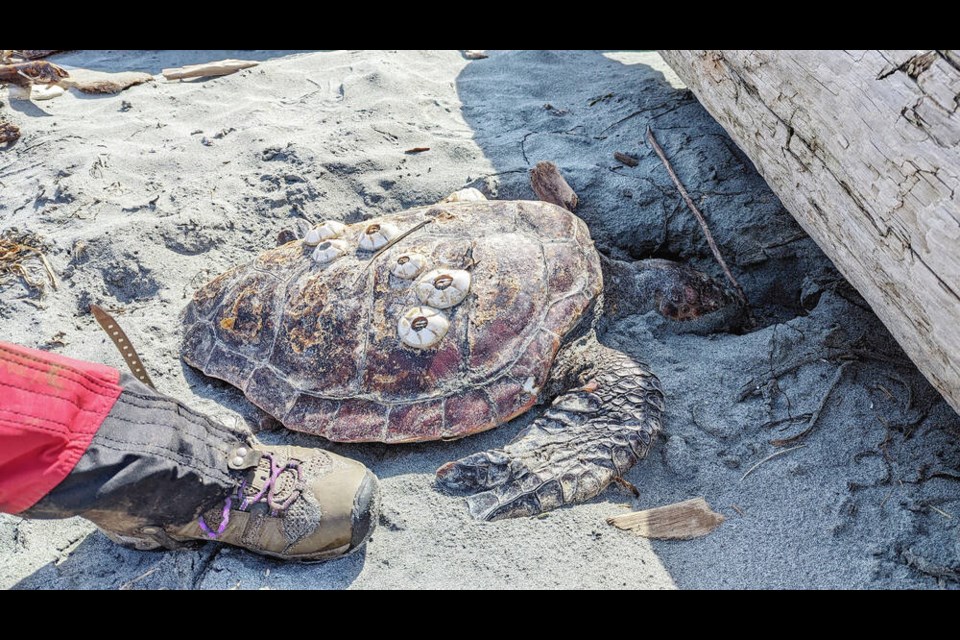Another loggerhead sea turtle has surfaced on Vancouver Island, hundreds of kilometres north of its natural range in the open Pacific Ocean.
The turtle was found dead on Friday by hikers at Nels Bight near Cape Scott on the North Island.
Andre Fillion of Courtenay was hiking on the beach with his sister, Len Lyle, and went to refill his water bottle from a creek when he noticed the shell. He said the animal appeared to have recently died, and one its front flippers had been gnawed by either a marten or mink, based on nearby tracks.
“It was behind some beach logs, but close to the open sand,” Fillion said. “I definitely did a double take. There was no sign of movement and we didn’t disturb it.”
Fillion said the tide was out and the loggerhead was about 100 metres or more from the water.
It was the second loggerhead turtle discovered on the Island in three months, after a 38-kilogram female was found alive but severely hypothermic in “cold shock” floating in bull kelp off Metchosin on Feb. 4.
The turtle, since named Moira, was rushed by local rescuers to the Vancouver Aquarium, where she is recovering and expected to be released in warmer ocean waters, likely in the San Diego area, in coming months.
Loggerhead sea turtles in B.C. waters are considered incredibly rare, said Lisa Spaven, a scientist in DFO’s aquatic ecosystem and marine-mammal section based in Nanaimo. The latest find is only the third confirmed sighting of a loggerhead sea turtle ever recorded in the province.
After the Metchosin discovery, the only previous report was in 2015 about 80 kilometres offshore from Tofino, when crew aboard a Canadian Coast Guard ship spotted a loggerhead.
Spaven, who examined Fillion’s photos on Monday, confirmed the turtle was a loggerhead and that it was “very likely dead.”
Turtles in cold shock can look deceased, she said, and can be brought back around when warmed up. However, in this case, she said the turtle may have been floating for a while.
The hard shell was encrusted with several large barnacles.
Spaven could not determine how long the animal had been there or what sex it was.
It’s still unclear why loggerhead sea turtles are ending up on Vancouver Island. Metchosin is about 500 nautical miles from the turtle’s northernmost range in the Pacific Ocean — and Cape Scott adds another 350.
The North Pacific loggerhead turtle, listed as an endangered species in the U.S., originates from nesting sites in Japan and roams the ocean in currents, occasionally foraging closer to land along the U.S. coast from Oregon down to Mexico. Males never return to land after hatching and females only go to a beach at their nesting sites in Japan to lay eggs.
Moira, estimated to be a “sub-adult” of 15 to 20 years old, was the first loggerhead taken into care in B.C.
Loggerheads can live up to 80 years and don’t reach breeding age until they’re over 30.
Spaven said the appearance of the dead loggerhead at Cape Scott and the live one called Moira could be linked.
She said it’s possible the two turtles were swept out of their range by currents at around the same time, with one landing in Metchosin on Feb. 4 and the other drifting to Cape Scott two months later.
Spaven speculated changing weather patterns and ocean temperatures as a result of climate change could be affecting the distribution of prey for the turtles, which are mainly carnivores.
There is a suggestion the turtles may have been in the warmer California current, but were swept into the colder Alaskan current that brought them to Vancouver Island.
Gavin Hanke, curator of vertebrate zoology at the Royal B.C. Museum, said loggerheads were said to be here years ago, but there have been no specimens or reliable photos.
“They must swim north in warm surface water and then when winter arrives and the surface cools, their metabolism slows and turtles wash up on our beaches,” said Hanke.
He said the same thing happens with green and Olive Ridley sea turtles.
“What we could be seeing if not an increase in turtle strays is an increase in people with phones and digital cameras, the ease at which we can share images, and an increase in awareness that these records are worth reporting,” said Hanke.
The museum and the DFO had no immediate plans to collect the dead loggerhead as a specimen. Fillion said the location co-ordinates are embedded in the photos supplied to both the DFO and museum
Hanke said the museum has green turtles and an Olive Ridley sea turtle in its collections.
Spaven said all sea turtles are rare in B.C. waters, though she has recorded a handful of cases of green and olive Ridley sea turtles, both hard-shell species. Soft-shelled leatherback sea turtles are more common, with about 150 sightings on the coast, because they are more tolerant of colder waters, she said.
>>> To comment on this article, write a letter to the editor: [email protected]




